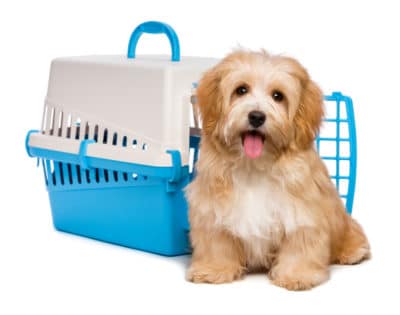 If you have teenage children — or remember what it was like to be a teenager — you’re aware of how important their bedroom is as a safe place.
If you have teenage children — or remember what it was like to be a teenager — you’re aware of how important their bedroom is as a safe place.
No matter what’s going on outside or how they feel inside, they can retire there, content in the knowledge that no one can bother them.
While kennels and crate training don’t have the best reputation, they’re actually the same kind of safe area and a great place for a new puppy or an older dog to retreat when it needs time out.
What’s more, if provided with puppy crate training tips and done properly, crate training can help with housebreaking, separation anxiety, confidence and day care for young puppies.
The better you get your pet acquainted with its crate as a young pup, the more it’ll love it as it gets older. It’s truly a wonderful tool for finding the perfect balance between obedience and confidence for your pet.
Why Are Crated Dogs Happy Dogs?
Dogs have a natural instinct to retreat to a small, quiet space when they’re struggling to cope with their feelings.
We understand that some people feel cruel putting their beloved furry puppy friend in a small enclosed space, but it genuinely replicates an environment they’d seek out in the wild.
Many experts recommend crate training a puppy from a young age so it’s fully prepared for any eventuality as an adult dog.
When done correctly, a crate trained dog is better equipped if there’s an emergency evacuation situation, it requires surgery, you go on vacation or it needs to come along on a long car ride.
There are also plenty of situations where a puppy may need to self-soothe and find a safe space. For example, if there are fireworks, construction works or storms, the puppy can curl up in its crate and feel secure.
Crate training is also incredibly useful for potty training, and makes the entire thing less stressful for you and your pet.
Help Your Puppy Go Potty in the Right Place
One of the most essential training steps when you get a new puppy is housebreaking, and a crate can be your best friend during this process. As den animals, dogs instinctively learn to not go potty where they sleep because it could alert predators to their whereabouts when they’re at their most vulnerable. Even a canine that’s never sniffed a night out in the cold has this instinct built into its brain.
With a crate, you can take advantage of its nature while also making training and behavior management much easier for you and your family.
Plastic Crates vs Wire Crates
A lot of experts and dog lovers prefer wire crates over plastic crates, due to the many advantages of the former. That said, plastic crates are preferable for some people. Read on to find out why.
Benefits of Wire Crates
- They’re collapsible, which makes them much easier to store.
- You can see your pet through the sides, which puts you and it at ease — particularly if it’s in there for an extended amount of time.
- Many metal crates come with a divider that lets you increase the space inside as your pup grows.
- In the very slim chance there’s an accident in the crate, there’s usually a plastic tray at the bottom to make cleanups easier.
- If you opt for a simple model with a single crate door, a wire crate can be very inexpensive.
Benefits of Plastic Crates
- You don’t need to put a blanket over the cage when your pup needs darkness.
- Plastic crates usually break into two pieces for easier storage, although they aren’t as convenient as the wire models.
- It’s easier to fill a plastic crate up with the dog’s smell if it’s headed to an unfamiliar location.
Crate Sizing
Your crate size will depend on the breed‘s common sizes.Your crate should be big enough to allow your puppy to stand up, turn around and stretch comfortably, but no bigger.
The sense of being in a small den is what makes it feel safe, so giving it too much space can be problematic. When you have a pup, there are two choices for wired crates and just one for plastic ones.
A wire dog crate will often come with a divider that lets you adjust the amount of space available as your ball of fluff gets bigger.

Is There an Age You Should Stop Using Your Dog’s Crate?
Dog crates don’t just help you teach your pup how to go potty or provide it with a space to unwind when it gets over excited; they also give it somewhere to feel safe when you’re not home.
Plus, it teaches the puppy to appreciate freedom and understand the behaviors necessary for it to get as much freedom as possible.
Successful crate training early on is something that’ll benefit your pet for the rest of its life. Crate time might become a necessity as the dog ages and becomes more susceptible to conditions such as arthritis, osteoporosis or diabetes.
Teaching a mature or elderly dog is much harder than teaching a puppy, so your choice to crate train will benefit you long into the future.
5 Puppy Crate Training Tips
The amount of time it takes to train your new puppy to use a crate depends on an array of factors, such as age, temperament and early experience.
The most important thing to remember is that the crate must have positive associations and be a treat rather than a punishment or your puppy won’t use the tool correctly.
Don’t try to jump ahead. Take small steps and make sure your pet has mastered each step before moving on to the next. Some quick tips:
Have a favorite toy and plenty of kibble close by — and ensure you have a rigorous playtime before sending it into its crate overnight for the first time. Here’s an explanation of how to crate train your new dog, step by step:
1. The First Time
The first step is to introduce your furry friend to its crate. Initially, you should remove the door and place a towel or blanket with familiar smells inside. Don’t try to force the puppy to go inside; it’ll find it in its own time. If your pup is reluctant to go inside, you can try the following:
- Stand near the crate and give your puppy lots of praise to start making a positive association.
- Lead a trail of kibble up to the entrance and place a few treats inside.
- If your puppy isn’t motivated by dog treats, put its favorite puppy toy inside.
This initial process might take a few hours, days or weeks, depending on your pet. Remember that patience and calm are paramount as you’re trying to get the dog to form a positive attachment to its crate.
2. Build Positive Association With the Crate
Now your puppy is familiar with the crate, you’re ready to move to the next step. Feeding your puppy meals in the crate is a sure-fire way to build positive association because dogs love their food so much!
Place the fresh dog food dish at the back of the crate and wait for the dog to go inside and start eating. When it’s engrossed in its food bowl, close the door but make sure you open it as soon as it’s finished.
The next meal time, keep the door shut for a short time after it’s finished and increase the amount of time a little bit for each subsequent meal.
3. Longer Periods While You’re Home
Once your puppy is happily eating meals in its crate and spending 10 minutes comfortably without whining or getting distressed, you can start adding a short amount of independent crate time to each day.
First, call the pup to the crate and give it a reward, then use a single-word command such as “inside” and encourage it to go in with a treat in one hand to give when it successfully goes in.
Once it’s in, give it a treat, shut the door and stay with it for around five minutes. Provided it’s not distressed, leave the room for a few minutes and try to return before the puppy whines.
Sit with it for a little longer, then let it out. Repeat this process several times a day and increase the period of time you’re away each time.
4. Short Periods of Time While You’re Out
Once your puppy can spend about half an hour in its crate without vocalizing or getting upset, you can start crating it when you go out for a short amount of time.
When you return, keep calm and avoid positive reinforcement of these reunion moments. Dogs can get anxious if they’re not trained correctly, and making them look forward to your return too much makes this worse.
5. Overnight
When you put your new dog in a crate overnight, keep it near you for the initial period so it feels safe and secure. Bear in mind that a young puppy won’t be able to hold urine all night, so you’ll need to wake up in the night so it can go on a potty break.
When it’s fully crate trained and sleeping comfortably in the crate at night, you can move it to a different spot if you’d prefer.
We Can Take Care of the Crate Training Process
At Pride and Prejudoodles, we have a wide selection of labradoodles and goldendoodles that have been through an extensive dog training program. We pick the pups with the finest coats, temperaments and health profiles, and they spend at least three months in the home of a certified dog trainer.
If you’re a busy family or don’t have the resources to start crate training, this is the best way to skip the most challenging behavioral stages.
The first year is the most crucial time for building a sense of security and introducing your pet to as many positive experiences as possible. You’re shaping its world and contributing to the development of a happy, healthy adult dog.
Whether you opt for a house trained pup or decide to tackle house training yourself, we’ve got the perfect furry family member for your home.
